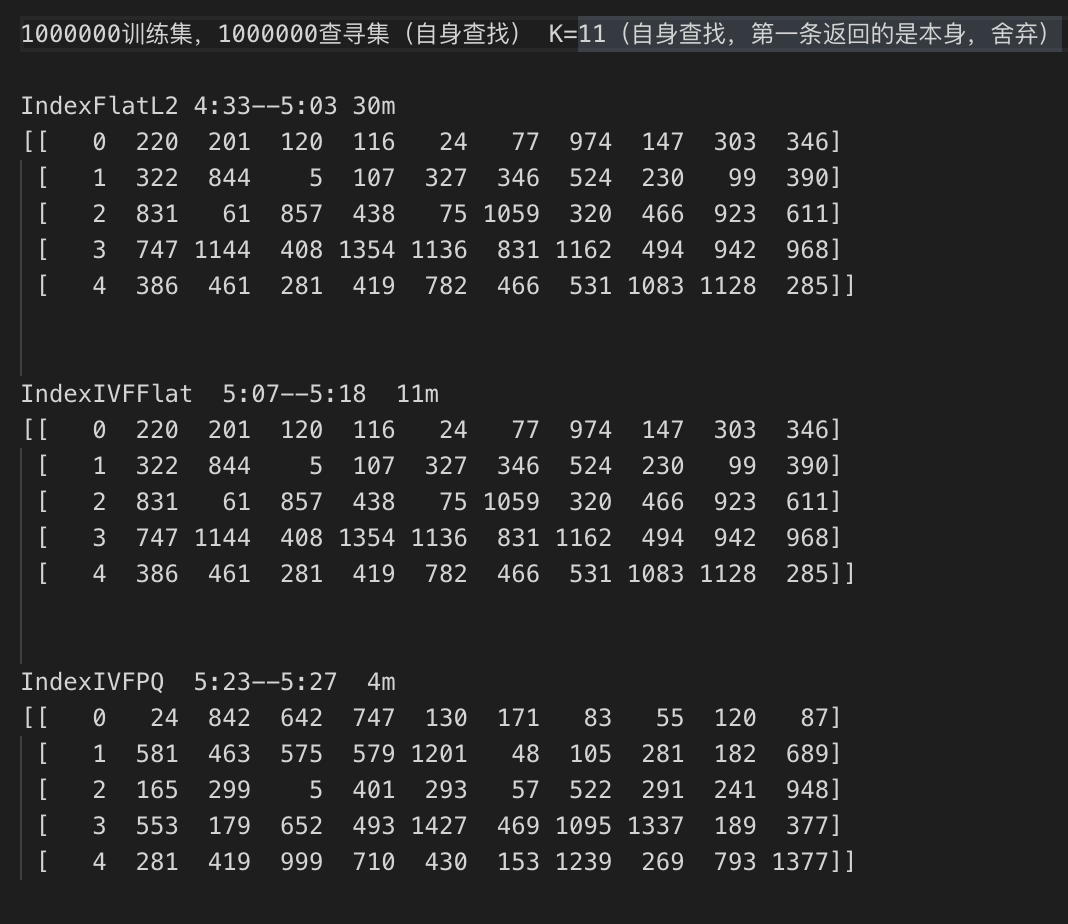上文针对Faiss安装和一些原理做了简单说明,本文针对标题所列三种索引方式进行编码验证。
首先生成数据集,这里采用100万条数据,每条50维,生成数据做本地化保存,代码如下:
import numpy as np
# 构造数据
import time
d = 50 # dimension
nb = 1000000 # database size
# nq = 1000000 # nb of queries
np.random.seed(1234) # make reproducible
xb = np.random.random((nb, d)).astype('float32')
xb[:, 0] += np.arange(nb) / 1000.
# xq = np.random.random((nq, d)).astype('float32')
# xq[:, 0] += np.arange(nq) / 1000.
print(xb[:1])
# 写入文件中
# file = open('data.txt', 'w')
np.savetxt('data.txt', xb)在上述训练集的基础上,做自身查询,即本身即是Faiss的训练集也是查寻集,三个索引的查询方式在一个文件内,如下示例代码:
import numpy as np
import faiss
# 读取文件形成numpy矩阵
data = []
with open('data.txt', 'rb') as f:
for line in f:
temp = line.split()
data.append(temp)
print(data[0])
# 训练与需要计算的数据
dataArray = np.array(data).astype('float32')
# print(dataArray[0])
# print(dataArray.shape[1])
# 获取数据的维度
d = dataArray.shape[1]
# IndexFlatL2索引方式
# # 为向量集构建IndexFlatL2索引,它是最简单的索引类型,只执行强力L2距离搜索
# index = faiss.IndexFlatL2(d) # build the index
# index.add(dataArray) # add vectors to the index
#
# # we want to see 4 nearest neighbors
# k = 11
# # search
# D, I = index.search(dataArray, k)
#
# # neighbors of the 5 first queries
# print(I[:5])
# IndexIVFFlat索引方式
# nlist = 100 # 单元格数
# k = 11
# quantizer = faiss.IndexFlatL2(d) # the other index d是向量维度
# index = faiss.IndexIVFFlat(quantizer, d, nlist, faiss.METRIC_L2)
# # here we specify METRIC_L2, by default it performs inner-product search
#
# assert not index.is_trained
# index.train(dataArray)
# assert index.is_trained
# index.add(dataArray) # add may be a bit slower as well
# index.nprobe = 10 # 执行搜索访问的单元格数(nlist以外) # default nprobe is 1, try a few more
# D, I = index.search(dataArray, k) # actual search
#
# print(I[:5]) # neighbors of the 5 last queries
# IndexIVFPQ索引方式
nlist = 100
m = 5
k = 11
quantizer = faiss.IndexFlatL2(d) # this remains the same
# 为了扩展到非常大的数据集,Faiss提供了基于产品量化器的有损压缩来压缩存储的向量的变体。压缩的方法基于乘积量化。
# 损失了一定精度为代价, 自身距离也不为0, 这是由于有损压缩。
index = faiss.IndexIVFPQ(quantizer, d, nlist, m, 8)
# 8 specifies that each sub-vector is encoded as 8 bits
index.train(dataArray)
index.add(dataArray)
# D, I = index.search(xb[:5], k) # sanity check
# print(I)
# print(D)
index.nprobe = 10 # make comparable with experiment above
D, I = index.search(dataArray, k) # search
print(I[:5])三种索引的结果和运行时长统计如下图所示:

从上述结果可以看出,加聚类后运行速度比暴力搜索提升很多,结果准确度也基本一致,加聚类加量化运行速度更快,结果相比暴力搜索差距较大,在数据量不是很大、维度不高的情况下,建议选择加聚类的索引方式即可。
来源:oschina
链接:https://my.oschina.net/u/4413763/blog/3604739